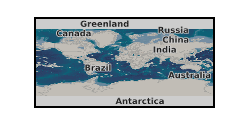Archaean
Type of resources
Topics
Keywords
Contact for the resource
Provided by
Years
Formats
Representation types
Update frequencies
-

Triple-sulfur isotope data from schists and carbonates in the Eoarchean Isua Greenstone Belt (3.7 Ga), using a new leaching technique and a multi-collector ICP-MS. The results reveal distinct pattern between the two lithologies and demonstrate an atmospheric contribution of sulfur in both cases. This may support the notion that these rocks represent metamorphosed marine sediments. However, hydrothermal alteration needs to be assessed in more detail to verify the antiquity of these signatures.
-

Nitrogen isotopic composition of microbial biomass grown in the laboratory under N2-fixing conditions. Also included are meta-data that describe the experimental conditions. The conditions were chosen to mimic specific parameters of the early Earth, in particular variable CO2 and O2 supplies, to test if d15N data recorded in ancient biomass in the rock record is affected. Also included are data from the wider literature for comparison, as well as the results of statistical tests.
-

The dataset consists of a table of 64 isotope ratio measurements of the AMES Ce standard (Willbold, 2007). The data was collected at Imperial College, London between April 2013 and March 2014 using a ThermoScientific Triton thermal-ionisation mass spectrometer following the technique described in Willbold, Journal of Analytical Atomic Spectrometry, 2007. The data is used to assess the reproducibility and accuracy of the mass spectrometric setup available at the time. Reference: Willbold, M., 2007. Determination of Ce isotopes by TIMS and MC-ICPMS and initiation of a new, homogeneous Ce isotopic reference material. Journal of Analytical Atomic Spectrometry, 22: 1364-1372 https://doi.org/10.1039/B705306A
-

The dataset includes measurements of dissolved and gaseous nitrogen oxides (nitrite, nitrate, NO(g)) generated by lightning discharge in a glass container partially filled with water, as well as measurements of dissolves sulfate and iron liberated from pyrite that has interacted with the nitrogen oxides. The lightning discharge experiments were carried out with either anoxic gas mixture (5% or 20% CO2 and the rest N2) or modern air. Lightning has long been identified as a source of reactive nitrogen species to Earth's early biosphere. These experiments were therefore conducted in order to test how this reactive nitrogen would interact with minerals at the Earth's surface. The results reveal that lightning-generated nitrogen oxides could have contributed to a small degree to oxidative weathering.
 NERC Data Catalogue Service
NERC Data Catalogue Service